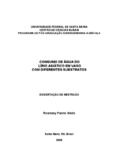| dc.creator | Mello, Rosmary Panno | |
| dc.date.accessioned | 2007-12-17 | |
| dc.date.available | 2007-12-17 | |
| dc.date.issued | 2006-02-23 | |
| dc.identifier.citation | MELLO, Rosmary Panno. Water consumption of the asian lily in vase with diferent substrata. 2006. 74 f. Dissertação (Mestrado em Engenharia Agrícola) - Universidade Federal de Santa Maria, Santa Maria, 2006. | por |
| dc.identifier.uri | http://repositorio.ufsm.br/handle/1/7490 | |
| dc.description.abstract | The purpose of the present study was to evaluate the water consumption in eight substrata: rice charred shell (CAC), ash of rice burned shell (CZ), coconut fiber (FC), soil of paradise (TP), TP+CAC, TP+CZ, FC+CAC and FC+CZ of Asian lily Orange Pixie in vase cultivation; to establish the best substrata for commercial production. The experiment was developed in the vegetation house of UFSM, Santa Maria, RS, during the period from May 17 to July 22, 2004. The experimental outlining was entirely casual by using 12 repetitions and three plants in each vase to determine the irrigation frequency and the water consumption for each substratum. In order to evaluate these parameters, limits were stipulated from at least 60% and at most 80% of the water retention capacity for the substratum in each vase being daily verified in digital scale. Due to the vegetative growing one vase of each treatment was destructed in five different periods of the lily development in order to readjust the weights of the vases in relation to the water consumption between the limits stipulated, besides establishing the evolution of the dry fitomass on aerial portion, bulbs and roots. The determinations accomplished on substrata were: the substratum density, the total porosity, the aerial space and the water availability as physics characteristics as well as the hydrogen potential, the total tenor of soluble salts and the capacity of cations exchange as chemical characteristics. In the vegetal were determined the height of the plant and of the first flower insertion, the area of the leaf, the size of the leaf, the number of flowers and leafs, the total consumption of water and the irrigation frequency. The results have showed that the Asian lily Orange Pixie in vase adapts for commercial cultivation by using 50% in volume of CAC in the substrata composition with FC and TP. | eng |
| dc.format | application/pdf | por |
| dc.language | por | por |
| dc.publisher | Universidade Federal de Santa Maria | por |
| dc.rights | Acesso Aberto | por |
| dc.subject | Irrigação | por |
| dc.subject | Substrato | por |
| dc.subject | Lírio asiático | por |
| dc.subject | Irrigation | eng |
| dc.subject | Substratum | eng |
| dc.subject | Asian lily | eng |
| dc.title | Consumo de água do lírio asiático em vaso com diferentes substratos | por |
| dc.title.alternative | Water consumption of the asian lily in vase with
diferent substrata | eng |
| dc.type | Dissertação | por |
| dc.description.resumo | Este trabalho teve como objetivos avaliar o consumo de água em oito substratos: casca de arroz carbonizada (CAC), cinza da casca de arroz queimada (CZ), fibra de coco (FC), terra do paraíso (TP), TP+CAC, TP+CZ, FC+CAC e FC+CZ de lírio asiático Orange Pixie® cultivado em vaso; definir os melhores substratos para produção comercial. O experimento foi conduzido na casa de vegetação da UFSM, Santa Maria, RS, no período de 17 de maio a 22 de julho de 2004. O delineamento experimental foi inteiramente casualizado, utilizando-se 12 repetições e três plantas por vaso para determinar a freqüência de irrigação e o consumo de água para cada substrato. Para a avaliação destes parâmetros, estipularam-se limites de no mínimo 60 % e no máximo de 80 % da capacidade de retenção de água pelo substrato em cada vaso, verificado diariamente em balança digital. Em função do crescimento vegetativo, efetuou-se a destruição de um vaso de cada tratamento em cinco períodos distintos do estádio fenológico do lírio, a fim de reajustar os pesos dos vasos quanto ao consumo de água entre os limites estipulados, e também determinar a evolução da fitomassa seca da parte aérea , dos bulbos e raízes. As determinações realizadas nos substratos foram: densidade do substrato, porosidade total, espaço aéreo e água disponível como características físicas e, potencial de hidrogênio, teor total de sais solúveis e capacidade de troca de cátions como características químicas. No vegetal foram determinada altura da planta e da inserção da primeira flor, área da folha, tamanho da flor, número de folhas e flores, consumo total de água e freqüência de irrigação. Os resultados evidenciaram que o lírio asiático Orange Pixie® em vaso se adapta para cultivo comercial, utilizando 50 %, em volume, de CAC na composição de substratos com FC e TP. Essa combinação não é a que mais consome água, mas a que exige maior freqüência de irrigações. | por |
| dc.contributor.advisor1 | König, Osvaldo | |
| dc.contributor.advisor1Lattes | http://lattes.cnpq.br/2405746065984064 | por |
| dc.contributor.referee1 | Peiter, Márcia Xavier | |
| dc.contributor.referee1Lattes | http://lattes.cnpq.br/4072803412132476 | por |
| dc.contributor.referee2 | Lopes, Sidinei José | |
| dc.contributor.referee2Lattes | http://lattes.cnpq.br/7533347017859354 | por |
| dc.publisher.country | BR | por |
| dc.publisher.department | Engenharia Agrícola | por |
| dc.publisher.initials | UFSM | por |
| dc.publisher.program | Programa de Pós-Graduação em Engenharia Agrícola | por |
| dc.subject.cnpq | CNPQ::CIENCIAS AGRARIAS::ENGENHARIA AGRICOLA | por |


